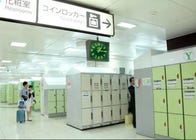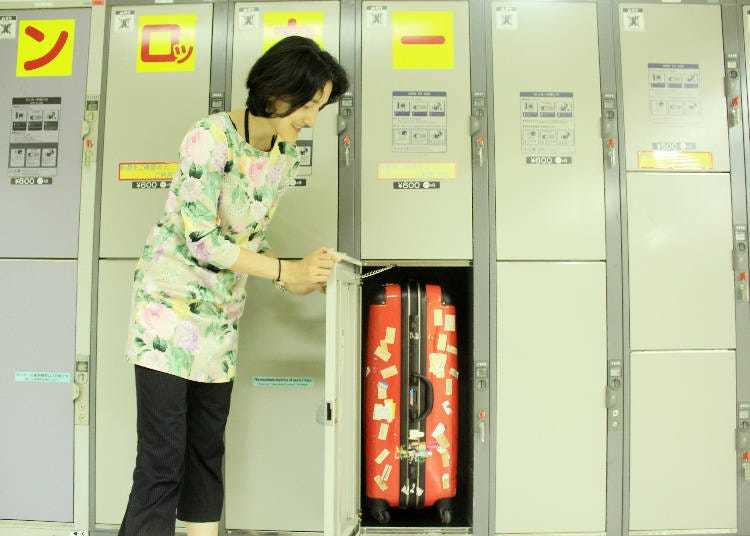
Toting around heavy suitcases and large baggage while traveling can be a hassle. Enter coin lockers! These handy storage solutions are commonly found at and around many Japanese train stations. They allow you to stow away your items right after disembarking, letting you dive right into your sightseeing plans.
This article will introduce everything you need to know about Japanese coin lockers, including their types, sizes, usage guidelines, FAQs, and where to find them. We'll also share some of the latest coin locker-related services, including search websites and online sharing platforms.
Coin Lockers in Japan: Types and Prices
Japanese coin lockers can be categorized into two main types. The most common type is the kind you'll find inside most train stations, many of which are located right near the ticket gates. In larger stations, you’ll usually find them both inside and around the station.
Key-Operated Coin Lockers
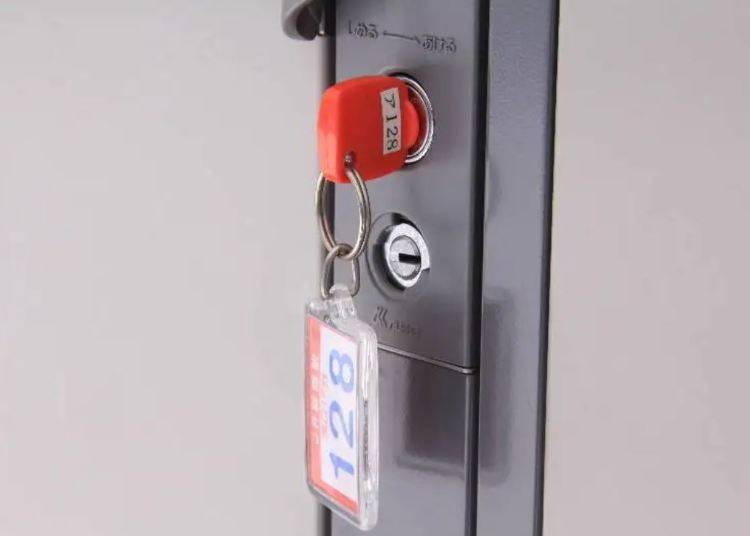
For these lockers, simply insert the exact fee amount in 100 yen coins. Then, turn the key and pull it out to activate the lock. This easy-to-use option is free of complicated steps, making them super user-friendly, even for travelers from abroad!
Note that most of these only accept 100-yen coins, with standard daily fees ranging from 200-400 yen (small), 400-600 yen (medium), and 600-800 yen (large).
Keyless Coin Lockers
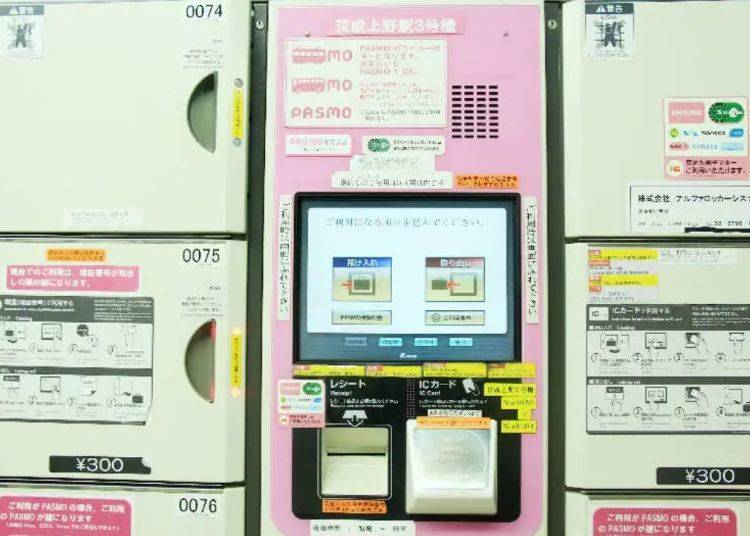
These are operated using a touch panel, with which you can check the availability of the locker as well as lock/unlock it, and secured using a PIN code or traffic IC card.
Acceptable payments are cash or IC card, such as Suica or PASMO. With cash payments, you can unlock it by entering a PIN code. For IC card payments, simply touch your card to the card reader. These lockers accept 500 yen coins, 1,000 yen bills, and IC cards such as Suica.
Note that PASMO cards can also be used for lockers labeled as “Suica”, and vice-versa. Transportation IC cards from areas outside of Tokyo (such as ICOCA, Kitaca, nimoca, SUGOCA, and TOICA) may also be accepted.
SPACER: The Smartphone-Enabled Smart Locker
Although availability of these are still quite limited, smart lockers known as “SPACER" allow travelers to use their smartphones to search for vacancies, as well as to lock and unlock them. With SPACER, users can remotely check availability, reserve a locker in advance, make cashless payments, and even share their key with family and friends.
Note that it requires downloading an app in order to use the system, although checking availability, and locking/unlocking can be completed with your phone alone. While installations are limited, SPACER lockers can be found in major stations such as Shinjuku, Shibuya, Ikebukuro, Osaka, and Hakata.
As of August 2023, the system is only available in Japanese, but has plans to introduce multi-language support in the future.
Coin Locker Fees
Whether you opt for key-operated or keyless, coin locker fees are calculated on a daily basis.
For smaller-sized luggage, expect to pay between 300-400 yen. Medium lockers are just slightly larger than the small ones, and typically range from 500-600 yen. For large baggage, such as suitcases, fees usually range from 700-800 yen.
If you need to store your luggage for more than one day, you will be charged an additional day’s fee, for a length of up to 3-4 days. However, be aware that if you stay past the expiration date, the locker management company may open your locker and confiscate your belongings.
Should this happen, the company may hold your belongings for up to a month, but expect to incur an extension fee if they do.
Recommended Locker Sizes by Luggage Type
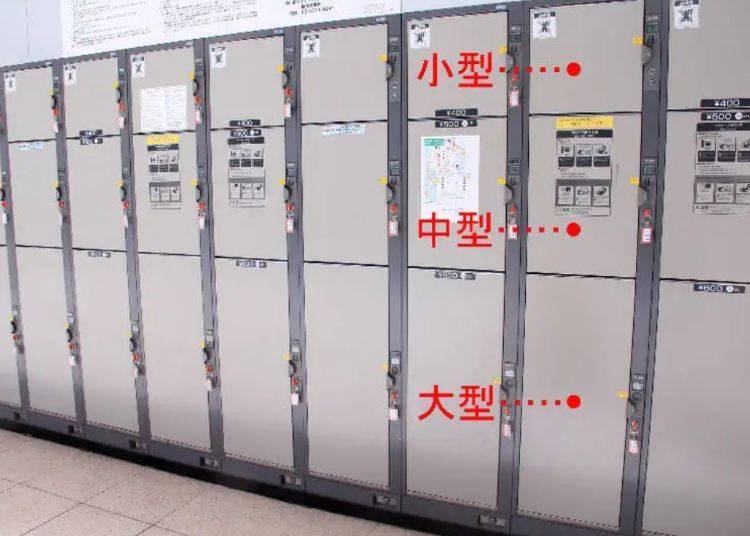
Coin-operated lockers come in four main sizes. Small lockers can hold shopping bags or a small backpack, while carry-on bags tend to fit better in medium-sized lockers or larger. If you're traveling with a suitcase, it’s probably best to opt for a large locker. Additionally, depending on where you are, some locations may even have extra-large lockers that can fit two carry-on bags, stacked vertically.
Coin Locker Sizes (varies by locker type)
- Good for:
- Bags, backpacks, shopping bags, etc.
- Average Price:
- 300-400 yen
- Average Size:
- ・257mm x 355mm x 575mm
・317mm x 355mm x 575mm
- Good for:
- Carry-on bags, small luggages too big for small lockers
- Average Price:
- 500-600 yen
- Average Size:
- 550mm x 355mm x 575mm
- Good for:
- Suitcases
- Average Price:
- 700-800 yen
- Average Size:
- 880mm x 355mm x 575mm
- Good for:
- Two carry-on bags, one suitcase and one bag
- Average Price:
- 900 yen
- Average Size:
- 1,153mm x 355mm x 575mm
How to Use Coin Lockers by Type
How to Use Key-Operated Coin Lockers
Key-operated coin lockers are often surprisingly full of vacancies, possibly because of the payment restriction to 100-yen coins. This option is recommended for those who do not have an IC card. Also, please note that availability of key-type coin lockers cannot be searched using the Suica locker search machines installed on the JR lines.

Depositing Your Luggage
1. Find an empty locker with a key.
2. Insert luggage and close door.
3. Insert exact fee amount in 100-yen coins.
4. Hold door, turn key to the left, and pull it out.
Removing Your Luggage
1. Check your locker number, and insert key.
2. Hold door, turn key to the right, and open.
Removing Luggage After Exceeding Basic Fee
1. Check locker number, insert key all the way in.
2. Insert excess fee (in 100-yen coins) as indicated above keyhole.
3. Hold door, turn key to the right, and open.
How to Use Keyless Coin Lockers
With keyless coin lockers, the touch panel is often available in English, Chinese, and Korean in addition to Japanese.

Depositing Your Luggage
1. Select “Deposit” (預け入れ) on the touch panel. Screen will then show "Put luggage in empty locker” (空きボックスに荷物を入れる).
2. Empty locker numbers will be displayed. Select your desired locker, and deposit your luggage.
3. Press the door shut to lock; a light will flash.
4. Select payment type: cash (PIN type) or IC card (Suica, PASMO, etc.)
5-a. For cash (PIN type): Insert fee and receive receipt with your PIN.
5-b. For IC card: Touch IC card to the reader, and take your receipt.
(*Regardless of whether you pay with cash or an IC card, be sure to keep your receipt somewhere safe–it has important information such as your locker location and the management company’s contact information. Also, be sure not to forget your PIN!)
Removing Your Luggage
1. Select Remove (取り出し) on the touch panel.
2. On the payment selection screen, select cash (PIN type) or IC card (Suica, PASMO, etc.). (This should be the same method you selected when you deposited your luggage).
3-a: For cash (PIN type): Select "Cash" (現金) and enter the PIN on your receipt.
3-b: For IC cards: Select "IC card” (ICカード) (Suica, PASMO, etc.) and touch your card to the reader.
4: Your locker will open, and you can remove your luggage.
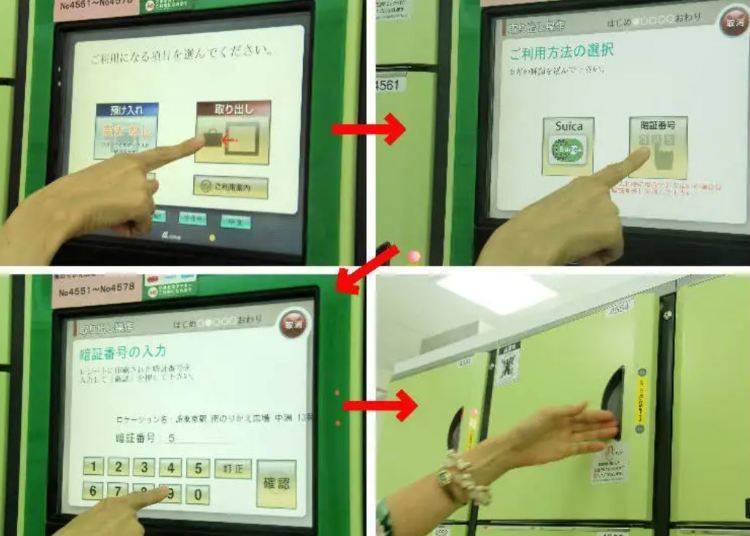
Removing Luggage After Exceeding Basic Fee
・For cash (PIN type), enter your PIN and insert the excess fee as displayed on the screen.
・For IC cards, the excess amount will be deducted from your card when you touch it to the reader.
Coin Locker FAQs
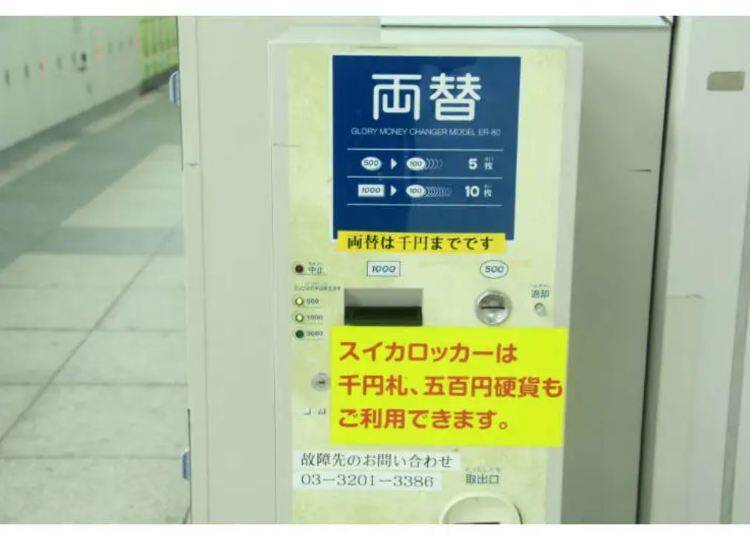
Q1) What if I don't have change? Can I exchange coins?
If you find yourself without change, some lockers may have change machines nearby. Note that these machines usually do not accept 5,000 or 10,000 yen bills, rather are designed for exchanging 1,000 yen bills and 500 yen coins for 100 yen coins.
If you can't find a change machine nearby, consider purchasing a drink from a vending machine, which will give you change in coins (as convenience stores and shops may not offer bill-to-coin exchange services). On the flip side, if you’re using a coin locker with a touch panel, it may be able to accept 1,000 yen bills.
Q2) What happens if I leave my belongings in the locker for more than one day?
In this case, you will incur additional fees. For key-operated lockers, the amount due is displayed when you insert your key. Simply insert the money to pay the fee.
For cash payment, select "Cash Payment" (現金支払い) on the touch screen, enter your PIN, and insert the displayed fee amount. For IC card payment, select “IC Card Payment” (ICカード支払い), and the amount will be deducted from your card when you tap it to remove your luggage.
Note that although the period may say “1 Day," this does not mean 24 hours from the start of use. Rather, it refers to the date of use, and your time is up once the date changes. The specific time of date change varies by locker, but it is usually around 1:00-2:00 a.m.
So, for example, if you deposit your luggage at 10:00 p.m. and retrieve it at 8:00 a.m. the following morning, you will be charged for two days' worth of storage.
Q3) What is the max number of days I can store my belongings? What happens after the expiration date?
Generally, coin lockers can be used for up to three days, starting from the first day of use (some lockers may be used for up to four days). After the expiration date, the management company will open the locker and confiscate your belongings. They will usually hold on to it for up to one month.
During that time, you will need to pay fees not only for the number of days your items were left in the locker, but also for the number of days they stayed with the management company, as well as the cost of replacing the key (several thousand yen). So be careful not to leave your belongings in any locker past the expiration date!
Q4) What items are not allowed in the lockers?
The following is a list of items that are not allowed to be stored in coin lockers, as stated in their terms and conditions of use.
Also, although it does not specifically mention food, it does state clearly that "items that emit odor" and "items considered unsuitable for storage" are not allowed, so be sure not to leave any raw or strong-smelling foods, or anything else unsuitable for storage, in any of your bags.
・Cash and securities
・Valuables (precious metals, antiques, important documents, credit cards, cameras, computers, etc.)
・Animals
・Hazardous materials (volatile, toxic, explosive, etc.)
・Items prohibited by law (weapons, etc.)
・Stolen goods / Anything obtained through illegal means
・Items that emit odors, are dirty, easily damaged, or may deface or damage lockers
・Other items considered unsuitable for storage
Q5) What if I lose my locker key or forget my PIN?
In the unfortunate event of losing your key or forgetting your PIN, be sure to contact the management company right away to have someone come to your locker. There, you will complete and submit a “Report of Loss (Key)" form before proceeding to retrieve your belongings. You will also need to present identification, as well as answer questions about the contents of your checked luggage.
In the case of losing the key, you will be responsible for covering the cost of a replacement key (usually several thousand yen), and if your items have exceeded the designated time in the locker, you will also be required to pay an over-use fee.
Management company contact information varies by locker, but is usually listed around the locker’s vicinity, so we recommend taking a note or photo of it before you leave, together with your locker number. Management business hours also vary by locker company, but in most cases are open from around 8-9:00 a.m. to around 8-10 p.m.
Q6) What if I lose my IC card that I used as a key?
If you happen to lose the IC card you used as your key, the process is similar to losing a physical key. Promptly contact the management company and present proof of identification (passport, driver's license, etc) and the required documents in order to retrieve your belongings. Please note that in the event that this occurs outside of the locker management center's business hours, service may not be available until the following day.
For lost IC cards (PASMO, SUICA, etc), first be sure to check the nearest station counter and police box in case they have been brought in as lost property. If your IC card uses the "auto-charge service," which automatically recharges your card when your remaining balance is low, you will need to disable that card. In this case, visit the nearest station counter to suspend the service. You will need to fill out a form and present your identification documents (passport, etc.).
Q7) What if I forget where my locker is?
Even if you forget the location of your locker, you’ll be fine as long as you still have your key or receipt. The keys for key-operated station lockers should have a keychain attached, on which you will find the locker number as well as the station name and location (for example: JR Shinjuku Station, East Exit, 1F, outside), making it easier to find your locker, even if you forget!
For touch-panel lockers, all receipts, regardless of payment method, will also have the locker number and location written on it (e.g., ABC Station North Exit / 123 Concourse South), along with the start date and time, amount, and management company contact information. If you can’t find your locker, simply show this receipt to a station attendant.
It’s also a good idea to take a picture of the locker and the surrounding area right after depositing your luggage to avoid losing track of your locker’s location.
Q8) What if there are no lockers available, or none in the right size?
In this case, you can explore other locker locations using "Coin Locker Navi.” This website allows you to search for coin lockers by location at stations and attractions all throughout Japan. The site also regularly updates locker availability at major stations such as Tokyo, making it easier to check for current locker vacancies.
However, please note that the service is only available in Japanese.
Suica Coin Locker Search machines are also available at Tokyo, Shinjuku, Ikebukuro, and Shinagawa Stations, which allow you to search for available Suica coin lockers in real-time. The coin locker icons on the station map will appear in green when there are many available, and orange when there are few. You can also check the number of vacancies by locker size by touching the icon. If you see one you like, it can also guide you from your present location to your desired locker.
However, if there are still no lockers available, you may want to consider alternative options, such as using a temporary baggage storage counter, shipping your luggage to your accommodation via courier, or using the "ecbo cloak" service, which allows you to store your belongings in vacant spaces within a shop. For more information, read on to our next section: Recommended Locker Services.
Recommended Locker Services
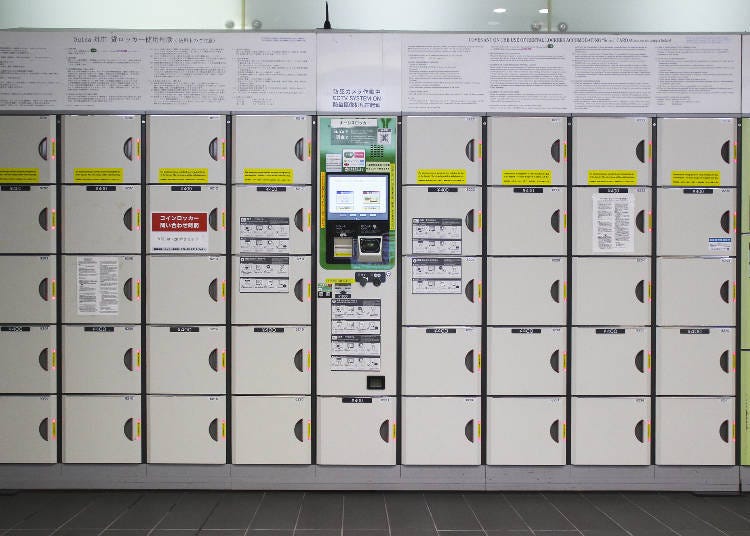
Locker Concierge
Locker Concierge is an online service that enables users to access information about the location, quantity, and availability of coin lockers within Tokyo Metro stations by size. At-a-glance icons indicate whether lockers are ”available," "few available," or "none available". Multilingual service is available in English, Simplified/Traditional Chinese, and Korean.
Coin Locker Navi
As mentioned above, this search site allows you to check locker availability all throughout Japan. Using location-based services and GPS functionality, you can search for coin lockers based on your current location. For the closest stations to Tokyo Disney Resort (Maihama Station, Tokyo Station Ichibangai, and Hankyu Osaka-Umeda Station), you can even see the current number of available lockers. Please note that this service is only available in Japanese.
ecbo cloak
This is an online sharing service that connects people who want to leave their luggage with establishments that have available storage space. Securely store your belongings in various locations, including cafes, beauty salons, post offices, select train stations, kimono rental shops, clothing stores, and more. After completing user registration, select the desired establishment in which to deposit your luggage, the date and time of drop-off, and the pickup date.
It’s also a great option for those with larger items that won't fit in conventional coin lockers. The rate is 500 yen per day for items with a maximum dimension of under 45 cm (backpacks, bags, etc.), and 800 yen for items with a maximum dimension of 45 cm or more (suitcases, musical instruments, baby strollers, etc.). Both the website and application are available in English and traditional Chinese.
For Airports and Train Stations: Visit the Temporary Baggage Storage Counter
If there are no available coin lockers in the airport, you can check out the temporary baggage storage counter. At Tokyo Station, baggage storage counters are available inside the Marunouchi Central Gate and outside the Yaesu South Gate. Additionally, at Shibuya Station, the Shibuya Chikamichi General Information Center (located in the B1F concourse of Shibuya Station on the Tokyu Line) offers baggage storage and delivery services for larger items that won't fit in regular coin lockers.
Yamato Transport Hands-Free Travel Service
Yamato Transport offers temporary baggage storage. Services are available at the Tokyo Station Marunouchi North Exit Baggage Service Counter, Asakusa Nakamise Center, and Tokyu Kabukicho Tower Tourist Information Center.
Tokyo Station Marunouchi North Exit Baggage Service
Tokyo Station Marunouchi North Exit Dome, 1-9-1 Marunouchi, Chiyoda-ku, Tokyo
Baggage Storage Service Hours: 8:30 a.m. - 8:00 p.m.
Languages: English
Available Services:
1) Temporary baggage storage
2) Same-day delivery
3) Souvenir and baggage shipment
Asakusa Nakamise Center
1-40-8 Asakusa, Taito-ku, Tokyo
Baggage Storage Service Hours: 8:30 a.m. - 8:00 p.m.
Languages: English
Available services:
1) Temporary baggage storage
2) Souvenir and baggage shipment
Tokyu Kabukicho Tower Tourist Information Center
1-29-1 Kabukicho, Shinjuku-ku, Tokyo
Baggage Storage Service Hours: 10:00 a.m. - 7:00 p.m.
Languages: English
Available services:
1) Temporary baggage storage
2) Souvenir and baggage shipment
Sagawa Express Tokyo “Sightseeing without Baggage” Service
Sagawa Express also provides temporary baggage storage (800 yen per day /500 yen at Tokyo Skytree® only), as well as same-day delivery to your accommodation. English and Chinese speaking staff are available at the Asakusa Kaminarimon Service Center.
Tokyo Station
Tokyo Service Center
First Avenue Tokyo Station 1F, 1-9-1 Marunouchi, Chiyoda-ku, Tokyo
Hours: 7:00 a.m. - 9:00 p.m.
Busta Shinjuku
Shinjuku Service Center
Tokyo Tourist Information Center, Busta Shinjuku 3F, 5-24-55 Sendagaya, Shibuya-ku, Tokyo
Hours: 6:30 a.m. - 11:00 p.m.
Asakusa Kaminarimon Service Center
2-1-3 Asakusa, Taito-ku, Tokyo
Hours:
Weekdays: 9:00 a.m. - 7:00 p.m.
Weekends/Holidays: 9:00 a.m. - 6:00 p.m.
Languages: English, Chinese
Skytree
Tokyo Skytree Town Service Center
Tokyo Skytree Town Solamachi Tower 1F, 1-1-2 Oshiage, Sumida-ku, Tokyo
Hours: 10:00 a.m. - 9:00 p.m.
Kyoto Station
Kyoto Station Delivery Service Counter
8-3 Higashishiokoji Takakura-cho, Shimogyo-ku, Kyoto-shi, Kyoto
Hours: 9:00 a.m. - 8:00 p.m.
From Airport to Hotel! Baggage Delivery Service
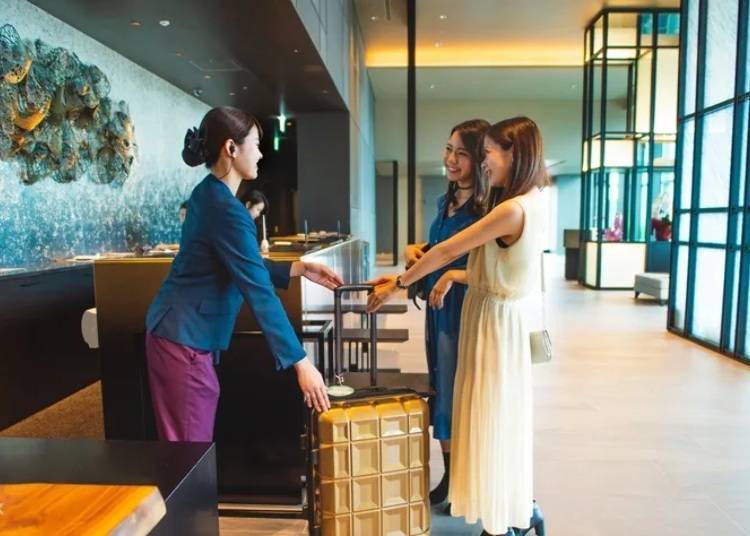
If you don’t want to leave your suitcase or other belongings in a locker, you can also choose to have them delivered from the airport to your accommodation, making it much easier to sightsee, luggage-free!
Locker Locations in Major Stations
- Tokyo Station
- ・Tokyo Station Marunouchi Central Exit (Near stair landing to Gransta, inside Tokyo Station's Marunouchi Central Exit ticket gates)
・Tokyo Station Marunouchi Central Exit (In front of the North Court of the ECUTE shopping facility, located inside Tokyo Station’s Marunouchi Central Exit ticket gates)
・Tokyo Station B1F Locker Corner (In Tokyo Station B1F central underground passageway, south transfer plaza)
- Shinjuku Station
- ・JR Shinjuku Station Southeast Exit (Outside JR Shinjuku Station Southeast Exit ticket gate to the left, just before the entrance of Lumine Shinjuku 2)
・Odakyu Line, Shinjuku Station South Exit (Next to stairs going toward Tokyo Metropolitan Government Office, right after exiting Odakyu Shinjuku Station South Exit ticket gate)
Related Article: Complete Guide to Shinjuku Station: Find the Shortest Route and Access to Your Destination
- Ueno Station
- ・JR Ueno Station, Shinobazu (Near Shinobazu exit corridor inside JR Ueno Station's Shinobazu ticket gate)
・JR Ueno Station Central Gate (Near bottom stairs on main entrance side)
・Tokyo Metro Ginza Line Ueno Station B1F (Near ticket office on the Marui side at Ueno Station on the Ginza Line)
- Osaka Station
- ・JR Osaka Station Sakurabashi Exit (Right in front of Sakurabashi Exit of JR Osaka Station)
・JR Osaka Station South Exit (Right before you as you exit the South Gate of JR Osaka Station)
- Shin-Osaka Station
- ・Shin-Osaka Station (Inside ticket gates of Shin-Osaka Station. Several locations available)
Related article: Osaka Station Area Guide: 10 Great Spots for Shopping & Sightseeing, Picked by Locals!
- Kyoto Station
- ・JR Kyoto Station Central Exit Bus Stop (Exit from central ticket gate of JR Kyoto Station and turn left before the bus stop)
・JR Kyoto Station F1 North Central Exit (Exit from central ticket gate on the first floor of JR Kyoto Station and head left for about 50 meters)
・Kyoto Subway Station, North Ticket Gate (On the right side of the north ticket gate of Kyoto Subway Station)
Related article: Kyoto Station Guide: Find Trains, Best Shopping, Restaurants, Souvenirs & More!
- Sapporo Station
- ・JR Sapporo Station South Exit (Near east-west connecting passageway at the South Exit of Sapporo Station)
・JR Sapporo Station North Exit (Near east-west connecting passageway at the North Exit of Sapporo Station)
Related article: Ultimate Guide to Sapporo Station: Lines, Sightseeing, Shopping and More!
- Sendai Station
- ・JR Sendai Station West Exit (Sendai Station West Exit, floors 1-3, various locations)
・Sendai Station 3F, Shinkansen Central Exit (Right next to the Shinkansen Central Exit ticket gates on the third floor of Sendai Station)
Now that you’re in Japan, you definitely want to make the most of your limited time by enjoying sightseeing and shopping to the fullest! So to avoid letting bulky baggage get in the way of your fun, consider dropping it off in a coin locker or storage facility to ensure a smooth, stress-free sightseeing experience!
*Information in article as of August 2023
English translation by: Krys Suzuki
Recommended Articles
- Category
*Prices and options mentioned are subject to change.
*Unless stated otherwise, all prices include tax.
Popular Tours & Activitiess
Recommended places for you
-
Events

Sunflower terminal (Osaka) Terminal 1
Other Sightseeing
USJ, Nanko Port
-

Kanzenkoshitsuyakinikutabehodai Gyugyu Paradise Sannomiya
Yakiniku
Kobe, Sannomiya, Kitano
-

Jukuseiniku-to Namamottsuarera Nikubaru Italian Nikutaria Sannomiya
Izakaya
Kobe, Sannomiya, Kitano
-
Goods

Yoshida Gennojo-Roho Kyoto Buddhist Altars
Gift Shops
Nijo Castle, Kyoto Imperial Palace
-
Appealing

Rukku and Uohei
Izakaya
Sapporo / Chitose
-

ANO-NE Kids Club
Other Sightseeing
Ginza
-

Keisei × Keikyu 16-Temple Goshuin Tour: Discover Deeper Tokyo & Yokohama
by: Guest Contributor
-

Don't Miss Out! The One Thing You Must Do Before Shopping at Mitsui Shopping Park LaLaport: Get Your Max 10% OFF Coupon Book
-

Enjoy Japan's Gorgeous Winter Lights! Ride the Romancecar to Shonan no Hoseki Illumination
by: Guest Contributor
-

[Extended Offer!](12% OFF KKday Coupon) Mt. Fuji Autumn Leaves, Powder Snow & More! 15 Best Tours to Experience Japan in Fall & Winter
-

Tokyo City Pass Upgrade: Harry Potter Studio Tour & Top Sights up to 85% Off
by: Guest Contributor
-

The Best Japanese Food Representing 2025! 'Dish of the Year®' Annual Award Results Announced
-

Explore a Magical Indoor Forest with teamLab's Latest Collaborative Illumination
by: Cassandra Lord
-

Popular Food at Universal Studios Japan
by: WESTPLAN
-

Osaka City Guide: Destinations, Activities, Travel Advice, Shopping & More
by: WESTPLAN
-

Why Osaka Tennoji Zoo is So Popular with Foreign Tourists (Guide & Highlights)
-

Hoshinoya Kyoto: This Incredible Japanese Hotel Welcomes You By Boat on a Sakura-Filled River
-

What to Do in Tokyo For a Day: 8 Must-Visit Spots from Asakusa to Roppongi
- #best sushi japan
- #what to do in odaiba
- #what to bring to japan
- #new years in tokyo
- #best ramen japan
- #what to buy in ameyoko
- #japanese nail trends
- #things to do japan
- #onsen tattoo friendly tokyo
- #daiso
- #best coffee japan
- #best japanese soft drinks
- #best yakiniku japan
- #japanese fashion culture
- #japanese convenience store snacks














